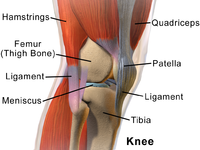
Photo from wikipedia
BACKGROUND Patellofemoral pain (PFP) is a common musculoskeletal disorder. Quadriceps and core muscle neuromuscular control impairments are frequently associated with PFP. Lumbopelvic manipulation (LPM) has been shown to improve quadriceps… Click to show full abstract
BACKGROUND Patellofemoral pain (PFP) is a common musculoskeletal disorder. Quadriceps and core muscle neuromuscular control impairments are frequently associated with PFP. Lumbopelvic manipulation (LPM) has been shown to improve quadriceps and core muscle activation and decrease their inhibition, but changes in balance and knee joint position sense (JPS) after this intervention remain unknown. OBJECTIVE To determine whether LPM decreases knee pain and JPS error and increases balance performance in patients with PFP. DESIGN Randomized controlled trial. SETTING Biomechanics laboratory at a rehabilitation science research center. METHODS Forty-four patients with PFP participated in this study that randomly divided into two equal groups. One group received LPM and the other received sham LPM (positioning with no thrust) in a single session. At baseline and immediately after the intervention, the outcomes of pain using a visual analog scale, balance using the modified star excursion balance test (mSEBT), and JPS at 20° and 60° of knee flexion using a Biodex dynamometer. RESULTS There was a statistically significant improvement in pain, balance control (anterior direction) and JPS in the LPM group immediately after the intervention. In addition, we observed significant differences between groups in pain, balance control (anterior direction) and JPS at 60° of knee flexion immediately after the intervention. CONCLUSION A single session of LPM immediately improved balance control, knee JPS, and pain in patients diagnosed with PFP. CLINICAL REHABILITATION IMPACT Findings suggest that LPM may be used as a therapeutic tool for immediate improvement of symptoms of PFP. However, more research is needed to determine long term results.
Journal Title: Journal of bodywork and movement therapies
Year Published: 2020
Link to full text (if available)
Share on Social Media: Sign Up to like & get
recommendations!